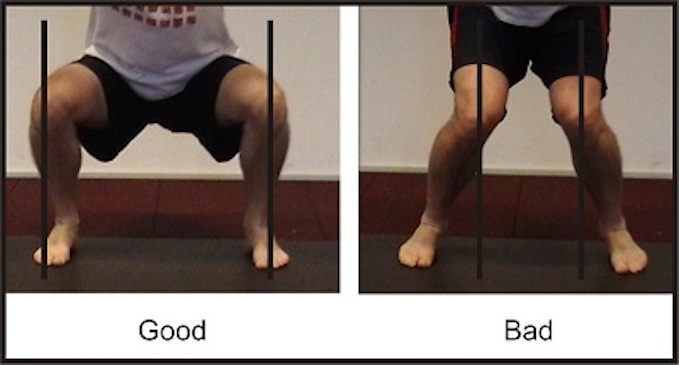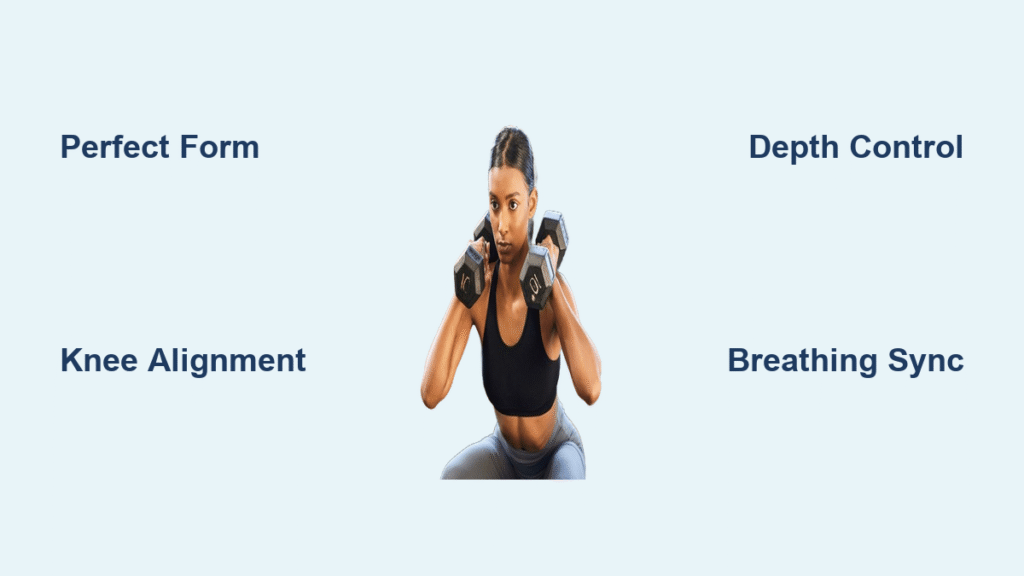That moment when your legs shake reaching for the fridge after a solid leg day? That’s the power of dumbbell squats—no fancy gym equipment needed. This single exercise torches calories while building functional strength for stairs, lifting, and athletic moves. You’ll discover exactly how to execute flawless form, avoid knee-pain pitfalls, and progress from basic squats to advanced variations that challenge even seasoned lifters. Let’s transform your lower-body training with this complete guide.
Most people grab dumbbells for bicep curls but miss their squat potential. Dumbbell squats uniquely engage your quads, glutes, hamstrings, and core simultaneously—boosting daily mobility and calorie burn. Unlike barbell squats, they demand less shoulder mobility while reducing spinal compression. Whether you’re a beginner or advanced lifter, mastering how to do squats with a dumbbell builds injury-resistant strength you’ll feel in every step.
Nail Your Dumbbell Squat Form Immediately

Starting Position Setup You Can’t Skip
Stand with feet shoulder-width apart, toes turned out 15-30 degrees. Hold dumbbells firmly at your sides (palms facing thighs) or cradled at shoulder height like a goblet. Distribute weight evenly across your entire foot—never shift onto your toes. Squeeze your glutes and brace your core as if tightening a belt two notches. Lift your chest while pulling shoulders back; this upright posture prevents dangerous forward lean. Check your alignment in a mirror: your ears, shoulders, hips, and ankles should form vertical lines.
The Exact Movement Pattern for Maximum Gains
Initiate each rep by hinging your hips backward like closing a car door with your butt. Bend your knees only after your hips move, lowering smoothly as if sitting into a chair behind you. Keep your spine neutral—no rounding or over-arching—until your thighs reach at least parallel to the floor. Your knees must track directly over your second and third toes without collapsing inward. At the bottom, drive upward by pressing through your heels (not toes!) while squeezing your glutes hard. Complete 12-15 reps per set with controlled 3-second descents.
Breathing Technique That Boosts Power
Inhale deeply through your nose as you descend, filling your belly to create core stability. Exhale sharply through pursed lips as you push up—this timing powers your ascent. Never hold your breath; it spikes blood pressure and weakens your core brace. Practice this rhythm empty-handed first: inhale for 3 counts down, exhale for 2 counts up. Once mastered, add light dumbbells to lock in the pattern.
Top Dumbbell Squat Variations for Every Goal
Goblet Squat: The Beginner’s Secret Weapon
Hold one dumbbell vertically against your chest, gripping the top plate with both hands. Keep elbows tucked inside knees as you squat. This counterbalance forces an upright torso, letting you hit proper depth safely. Pro tip: Place a yoga block between your knees—if you squeeze it during the rep, you’ll activate glutes and prevent knee cave-in. Start with 5-10lb weights for 3 sets of 15 reps to build flawless mechanics.
Bulgarian Split Squat: Fix Muscle Imbalances
Place your rear foot on a bench 2-3 feet behind your front foot, holding dumbbells at your sides. Lower until your back knee nearly touches the floor while keeping your front thigh parallel to ground. Watch for this mistake: letting your front knee drift past toes—keep it aligned with your ankle. Push explosively through your front heel to stand. Do 10 reps per leg for 3 sets to build single-leg power that translates to better running and jumping.
Sumo Squat: Unlock Glute and Inner Thigh Power
Take a wide stance (1.5x shoulder width) with toes turned out 45 degrees. Hold one dumbbell vertically between your legs or two at shoulder height. As you squat, actively push your knees outward against imaginary resistance. This targets your adductors and glute medius—key for hip stability. Time-saving hack: Place a resistance band above your knees to amplify muscle engagement. Perform 12 reps for 3 sets, descending slowly for 4 seconds.
Cyclist Squat: Quad Dominator
Stand with feet close together (6 inches apart), heels elevated 2 inches on weight plates. Hold one dumbbell at chest level. Squat past parallel, then drive up explosively while stopping 10 degrees short of knee lockout. This constant tension shreds quads. Critical cue: Keep your weight in your heels—rising onto toes shifts stress to knees. Use 8-12 reps for 3 sets to build athletic explosiveness.
Fix These 3 Dumbbell Squat Mistakes Immediately

Knee Collapse That Wrecks Joints
If your knees cave inward during how to do squats with a dumbbell, you’re risking ACL tears. Fix it now: Place a resistance band around your knees and press outward against it during each rep. Do 2 sets of 20 bodyweight squats as a warm-up to activate glutes. Reduce weight until you master this—never sacrifice form for heavier dumbbells.
Forward Torso Lean Stealing Power
Leaning too far forward shifts work from glutes to lower back. Solution: Perform goblet squats holding a 10lb dumbbell against your chest for 5 sets of 8 reps. This counterbalance teaches upright positioning. Also, foam roll your hip flexors daily—tightness here forces anterior pelvic tilt.
Shallow Depth Sabotaging Growth
Stopping above parallel skips glute activation. Progress safely: Place a yoga block under your heels if ankle mobility limits depth. Squat until your hips lightly touch a box set at parallel height. Key rule: Prioritize full range of motion with light weights over partial reps with heavy dumbbells.
Equipment Hacks for Safer, Stronger Squats
Choosing Dumbbells That Prevent Injury
Grab weights letting you complete 12-15 reps with perfect form. Women start with 5-10lb dumbbells; men with 10-20lb. Warning: Jumping too heavy too fast causes form breakdown. Use adjustable dumbbells for micro-increments—adding just 2.5lbs weekly builds strength without joint strain.
Footwear That Actually Helps (Not Hurts)
Ditch cushioned running shoes—they create instability. Wear flat-soled shoes like Converse or go barefoot on rubber gym floors. Pro move: Tape your toes together during squats to engage foot muscles for better balance.
Surface Setup for Zero Slips
Stand on a thin exercise mat over concrete—not thick foam that wobbles. Clear 3 feet of space behind you to avoid hitting walls during descent. Safety check: Press your feet into the floor for 5 seconds before squatting to test surface grip.
Program Your Squats for Real Results
Beginner Plan: Build Bulletproof Form
Do 2 sets of 12 goblet squats twice weekly. Rest 90 seconds between sets. Critical: Film yourself squatting to spot form flaws. Stop if knees hurt—try chair-assisted squats (tap a chair lightly at parallel depth) until mobile.
Intermediate Plan: Add Serious Muscle
Perform 3 sets of 10 sumo squats followed by 3 sets of 8 Bulgarian split squats twice weekly. Rest 2 minutes between sets. Progression: Add 5lbs to dumbbells weekly once you hit all reps cleanly.
Advanced Plan: Max Strength Gains
Complete 4 sets of 6 offset front rack squats (one dumbbell on shoulder) with 3-minute rests. Next-level tip: Pause 3 seconds at the bottom of each rep to build explosive power out of the hole.
Dumbbell squats deliver unmatched lower-body transformation with minimal equipment. Start with goblet squats to master the pattern, then systematically progress to advanced variations. Remember: Perfect form with light dumbbells beats sloppy heavy lifts every time—your knees and results will prove it.
Key Takeaway: Your first 4 weeks should focus exclusively on depth and alignment—not weight. Record a weekly video comparing your form. Once you hit parallel smoothly for 15 reps with 15lb dumbbells, then increase resistance. This patience builds the foundation for lifelong strength without injury.




